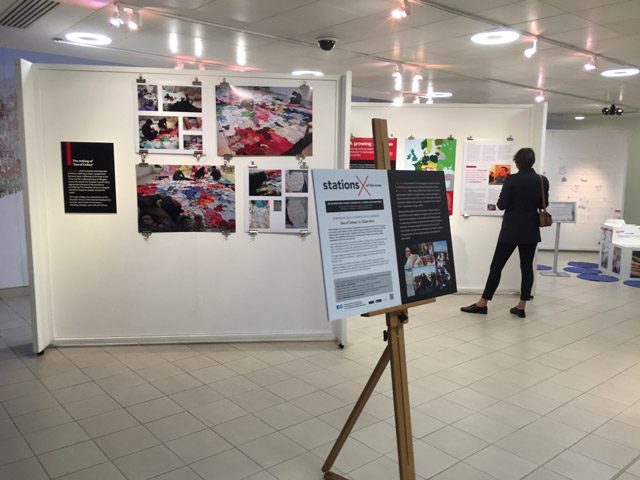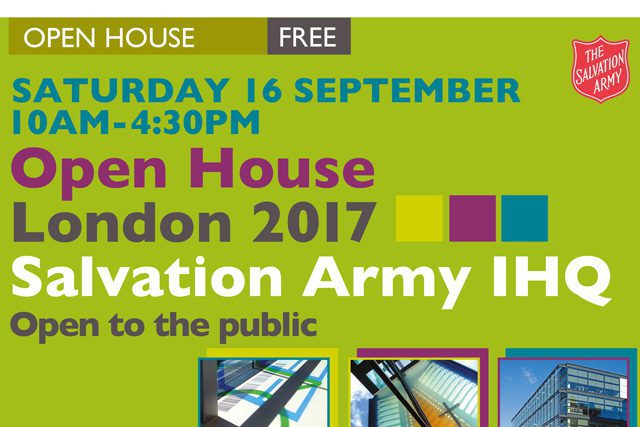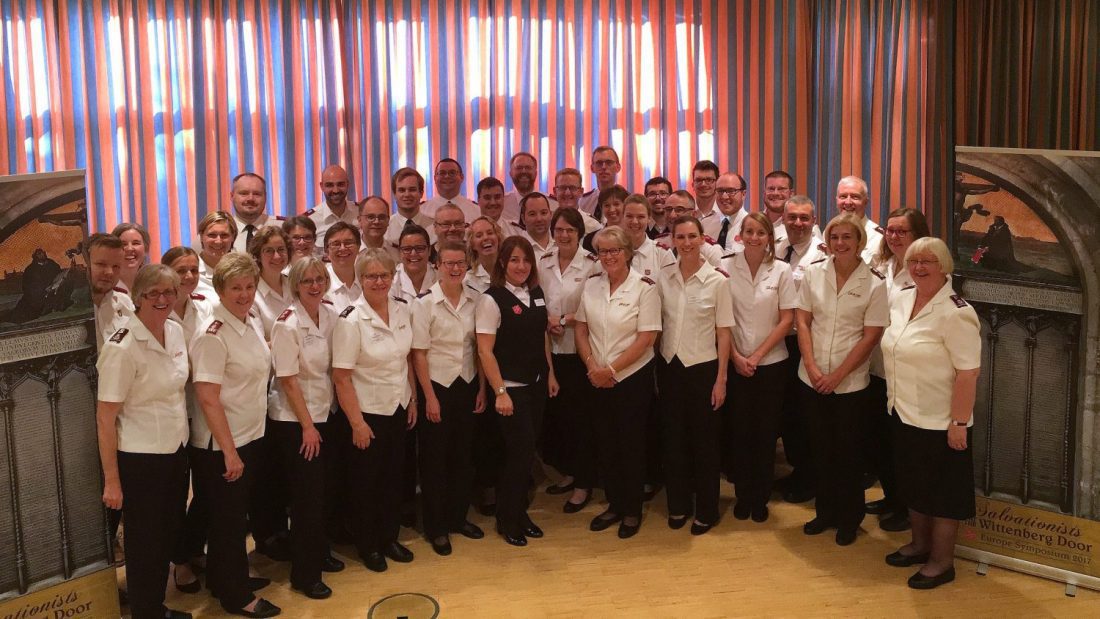Listen to this article
Listen to this article
Loading
Play
Pause
Options
0:00
-:--
1x
Playback Speed- 0.5
- 0.6
- 0.7
- 0.8
- 0.9
- 1
- 1.1
- 1.2
- 1.3
- 1.5
- 2
Audio Language
- English
- French
- German
- Italian
- Spanish
Open text
transparency marks new ihq facility. army returns home to 101 queen victoria st. by charles king, major –. communications secretary ihq november 9, 2004 – london. the salvation army’s international leaders joined british royalty and other international dignitaries in dedicating the army’s newly constructed international headquarters at 101 queen victoria street, london, england today. built at no cost to the army, the very modern but unostentatious building is located on a portion of the same site purchased by the army’s founder, william booth, in 1881. it replaces two prior headquarters structures. designed by the distinguished london architectual firm sheppard robson, the building fully captures the vision of general john gowans (ret.), the army’s sixteenth general and international leader during the planning process. then general gowans expressed the point of view that it must be transparent, open and welcoming—fit to reach out to the modern world. commissioner brian taylor, international secretary for business administration, was the prime mover for the entire process and saw the project through to completion prior to his promotion to glory a few days before the dedication. general john larsson, current international leader, stated that the intent of the building was to be modern in design, frugal in operation and evangelical in purpose. “and here now it stands,” he said. “we believe that the structural aims have been achieved. the task before us now is to put into practice the aims that relate to its functioning. “in this era of down-sizing,” larsson continued, “i am pleased to tell you that this is the smallest international headquarters building the army has ever had. the reason,” he said, “is not that the army itself is getting smaller – indeed, it is larger today than it has ever been. this building reflects the separation of our international work and the administration of the united kingdom territory that took place in 1990,” he said. the smaller building is much more suited to the needs of today.” in a telephone interview with new frontier, commissioner william francis, international secretary for the americas, said: “ any salvationist walking through the building will be proud of this structure. its glass exterior communicates our transparency, and inside there is a clear focus on our mission that reminds all visitors of our vision of the gospel and our commitment to fulfilling the great commission of christ.” francis noted that approximately 1,000 people pass the building each day as it stands on a line from st. paul’s cathedral to the millennium bridge spanning the river thames. paying the bill. of particular interest to salvationists around the world is the cost and source of funds for construction. the original freehold purchased by booth included three sites – 97, 99 and 101 queen victoria street. having discovered that space needs for the new building were considerably smaller than those in the original structure, army leaders decided to construct a commercial building on the first two sites and reserve 101 for the army. negotiations took place with hines, an american real estate company looking to establish a presence in the uk to complement widespread global activities. hines agreed to a transaction whereby in return for a 150 year lease on the 99 queen victory street site they would provide funds necessary for the construction of the army’s building at 101. in effect, two buildings are visually united with a distinctive outer surface resulting in a bigger presence on the street for the army than it actually has. hines stated: “having founded hines uk in summer 2000, we were looking to establish a central london presence on a site where we could make a difference. we were particularly attracted by the ambition of the army and the dynamism of the location adjacent to the millennium bridge in a part of the city seeing extensive change. “we love the ambition of the building. it could have been a mixture of brick and stone to reflect the adjoining properties, but pleasingly, the army has pushed hard to create something dynamic. we believe that what it has achieved is something fantastic. the result is a building that will grab people as they pass, and indeed, as we have seen since the building was unwrapped, it makes a standing contribution the local architecture and environment.” francis noted that the firm will also pay 250,000 pounds a year as a lease on the land. this figure will be renegotiated every five years. making the building work. the function of international headquarters is the handling of day-to-day business, the allocation of resources, and strategic, long-range planning. it acts as a resource center for the worldwide army and a facilitator of ideas and policies. entrance is achieved from the pedestrian walkway that carries foot traffic directly to the river and the millennium bridge. upon entry, a lower-level is evident below an entry bridge spanning the level. this level comprises the main public space – a type of “forum”, alive and active and visible, housing a cafeteria – “101 café,” a visitors center and five conference rooms. the first floor provides accommodations for the general and his chief of the staff, their spouses, and their private secretaries. without doubt, however, the most dramatic space on this floor is the chapel – a centerpiece hanging over part of the lower level and radiating a golden light at night. the walls consist of two layers of glass, one translucent and the other colored and reflecting a warm amber. this retains privacy inside the chapel and provides a reflecting image of the sky with all of its intricate movement and color. above the general are three floors of office space. the zonal leaders have offices on the second floor. a most enlightened design feature has the staff members who are most often present in the building in offices around the edge of the floors. above the zonal offices are other aspects of international administration, space for the leadership. the notion of engaging the public in a lively, non-threatening manner is continued through the imagery and signage used throughout the building. international faces and costumes form backdrops and partitions, quotes from the bible wrap around facades and meeting rooms, and simple religious icons such as the ‘five loaves’ bring life to the cafe and help link the secular with the religious while demonstrating our international and evangelical aspects. the use of transparent materials, color and light – even in the lettering and imagery itself –gives further expression to the ethos behind the army.
Open context player
Close context player
Plays:-Audio plays count
transparency marks new ihq facility. army returns home to 101 queen victoria st. by charles king, major –. communications secretary ihq november 9, 2004 – london. the salvation army’s international leaders joined british royalty and other international dignitaries in dedicating the army’s newly constructed international headquarters at 101 queen victoria street, london, england today. built at no cost to the army, the very modern but unostentatious building is located on a portion of the same site purchased by the army’s founder, william booth, in 1881. it replaces two prior headquarters structures. designed by the distinguished london architectual firm sheppard robson, the building fully captures the vision of general john gowans (ret.), the army’s sixteenth general and international leader during the planning process. then general gowans expressed the point of view that it must be transparent, open and welcoming—fit to reach out to the modern world. commissioner brian taylor, international secretary for business administration, was the prime mover for the entire process and saw the project through to completion prior to his promotion to glory a few days before the dedication. general john larsson, current international leader, stated that the intent of the building was to be modern in design, frugal in operation and evangelical in purpose. “and here now it stands,” he said. “we believe that the structural aims have been achieved. the task before us now is to put into practice the aims that relate to its functioning. “in this era of down-sizing,” larsson continued, “i am pleased to tell you that this is the smallest international headquarters building the army has ever had. the reason,” he said, “is not that the army itself is getting smaller – indeed, it is larger today than it has ever been. this building reflects the separation of our international work and the administration of the united kingdom territory that took place in 1990,” he said. the smaller building is much more suited to the needs of today.” in a telephone interview with new frontier, commissioner william francis, international secretary for the americas, said: “ any salvationist walking through the building will be proud of this structure. its glass exterior communicates our transparency, and inside there is a clear focus on our mission that reminds all visitors of our vision of the gospel and our commitment to fulfilling the great commission of christ.” francis noted that approximately 1,000 people pass the building each day as it stands on a line from st. paul’s cathedral to the millennium bridge spanning the river thames. paying the bill. of particular interest to salvationists around the world is the cost and source of funds for construction. the original freehold purchased by booth included three sites – 97, 99 and 101 queen victoria street. having discovered that space needs for the new building were considerably smaller than those in the original structure, army leaders decided to construct a commercial building on the first two sites and reserve 101 for the army. negotiations took place with hines, an american real estate company looking to establish a presence in the uk to complement widespread global activities. hines agreed to a transaction whereby in return for a 150 year lease on the 99 queen victory street site they would provide funds necessary for the construction of the army’s building at 101. in effect, two buildings are visually united with a distinctive outer surface resulting in a bigger presence on the street for the army than it actually has. hines stated: “having founded hines uk in summer 2000, we were looking to establish a central london presence on a site where we could make a difference. we were particularly attracted by the ambition of the army and the dynamism of the location adjacent to the millennium bridge in a part of the city seeing extensive change. “we love the ambition of the building. it could have been a mixture of brick and stone to reflect the adjoining properties, but pleasingly, the army has pushed hard to create something dynamic. we believe that what it has achieved is something fantastic. the result is a building that will grab people as they pass, and indeed, as we have seen since the building was unwrapped, it makes a standing contribution the local architecture and environment.” francis noted that the firm will also pay 250,000 pounds a year as a lease on the land. this figure will be renegotiated every five years. making the building work. the function of international headquarters is the handling of day-to-day business, the allocation of resources, and strategic, long-range planning. it acts as a resource center for the worldwide army and a facilitator of ideas and policies. entrance is achieved from the pedestrian walkway that carries foot traffic directly to the river and the millennium bridge. upon entry, a lower-level is evident below an entry bridge spanning the level. this level comprises the main public space – a type of “forum”, alive and active and visible, housing a cafeteria – “101 café,” a visitors center and five conference rooms. the first floor provides accommodations for the general and his chief of the staff, their spouses, and their private secretaries. without doubt, however, the most dramatic space on this floor is the chapel – a centerpiece hanging over part of the lower level and radiating a golden light at night. the walls consist of two layers of glass, one translucent and the other colored and reflecting a warm amber. this retains privacy inside the chapel and provides a reflecting image of the sky with all of its intricate movement and color. above the general are three floors of office space. the zonal leaders have offices on the second floor. a most enlightened design feature has the staff members who are most often present in the building in offices around the edge of the floors. above the zonal offices are other aspects of international administration, space for the leadership. the notion of engaging the public in a lively, non-threatening manner is continued through the imagery and signage used throughout the building. international faces and costumes form backdrops and partitions, quotes from the bible wrap around facades and meeting rooms, and simple religious icons such as the ‘five loaves’ bring life to the cafe and help link the secular with the religious while demonstrating our international and evangelical aspects. the use of transparent materials, color and light – even in the lettering and imagery itself –gives further expression to the ethos behind the army.
Listen to this article














